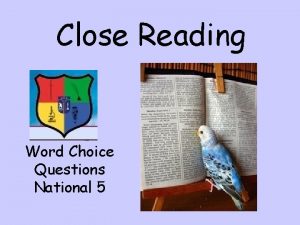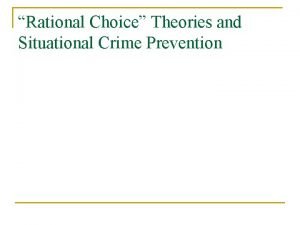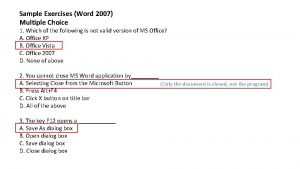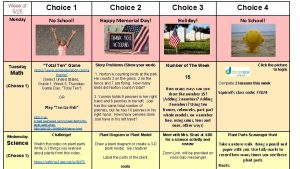Choice 1 Choice 2 Choice 3 Choice 4























- Slides: 23


Choice 1 Choice 2 Choice 3 Choice 4 100 100 200 200 300 300 400 400 500 500

b. the eight-level system Today, what system based on shared characteristics is used to classify organisms? a. sets of encyclopedias b. the eight-level system c. notes and photographs d. drawings and graphs 100

c. phylum, class, order In order, what are three levels of classification in addition to domain, kingdom, family, genus, and species? a. b. c. d. phylum, order, class, order, phylum, class, order, genera 100

a. the identity of an organism What can you find by working through the statements in a dichotomous key? a. b. c. d. the identity of an organism how many animals are birds how long a fungus can live when a species of organisms appeared on Earth 100

d. genus and species. The scientific name for an organism comes from its a. b. c. d. main characteristic. kingdom and phylum. order and class. genus and species. 100

b. plants or animals For hundreds of years, how were all living things classified? a. b. c. d. living or nonliving plants or animals water creatures or land creatures large or small 200

a. They discovered new organisms. What happened that made it necessary for scientists to add new domains and kingdoms? a. They discovered new organisms. b. They learned to write clearly. c. They started using photography. d. They discovered Euglena. . 200

c. three How many domains are recognized today? a. b. c. d. four Five three ten 200

b. Classification The division of organisms into groups or classes based on characteristics is a. b. c. d. taxonomy. Classification life science. biology. 200

a. taxonomy. The science of describing, classifying, and naming organisms is a. b. c. d. taxonomy. classification. life science. organization. 300

a. founding the science of taxonomy. Carolus Linnaeus is known for a. b. c. d. founding the science of taxonomy. discovering retractable claws. identifying the characteristics of rare species. discovering Tyrannosaurus rex. 300

c. domain, kingdom, phylum, class, order, family, genus, species. The eight levels of classification, from general to specific, are a. b. c. d. domain, kingdom, class, order, phylum, family, genus, species. domain, kingdom, phylum, class, family, order, genus, species. domain, kingdom, phylum, class, order, family, genus, species. domain, kingdom, class, phylum, order, family, genus, species. 300

d. Plantae. A pine tree is a member of the kingdom a. b. c. d. Animalia. Fungi. Protista. Plantae. 300

c. Animalia The organisms in what kingdom usually move by themselves and have specialized sense organs that allow them to respond to their environment? a. b. c. d. Fungi Plantae Animalia Protista 400

b. Domesticus The scientific name for the common house cat is Felis domesticus. What is its species name? a. b. c. d. Felis Domesticus house cat feline 400

d. characteristics. Scientists classify organisms based on their a. b. c. d. likes and dislikes. numbers in the wild. age. characteristics. 400

c. scientific names What do scientists use to refer to organisms because common names can create confusion? a. b. c. d. Latin names Nicknames scientific names first names 400

b. describing, classifying, and naming living things What is the science of taxonomy? a. b. c. d. naming plants and animals describing, classifying, and naming living things measuring living things taking pictures of living things 500

c. Hippocampus The seahorse found along the Atlantic Coast of the United States has the scientific name Hippocampus hudsonius. To what genus does the seahorse belong? a. b. c. d. fish Horse Hippocampus hudsonius 500

a. when they discovered organisms that did not fit into either group When did scientists stop classifying living things as either plants or animals? a. b. c. d. when they discovered organisms that did not fit into either group when they got tired of classifying organisms when they decided to include nonliving things when they got confused over common names 500

d. They absorb and digest them. How do fungi take in and use nutrients from their surroundings? a. b. c. d. They capture and kill them. They chop and swallow them. They absorb and chew them. They absorb and digest them. 500

FINAL JEOPARDY: look at the dichotomous key Chen saw a wingless animal that was brown on its face and body with white on its belly. It also had a long furry tail with a black tip. Use the dichotomous key to determine which of the following animals Chen saw. A. a striped skunk B. a little brown bat C. a long tailed weasel D. a white-footed mouse
 Good choice or bad choice
Good choice or bad choice Beyond multiple choice
Beyond multiple choice Marketing: real people, real choices
Marketing: real people, real choices The infinity gauntlet
The infinity gauntlet The theory of consumer choice chapter 21 practice
The theory of consumer choice chapter 21 practice Greedy algorithm properties
Greedy algorithm properties Nordic choice member
Nordic choice member Space matrix example
Space matrix example Statement of choice
Statement of choice Graphic text osslt
Graphic text osslt Eucharist multiple choice questions
Eucharist multiple choice questions Word choice questions national 5
Word choice questions national 5 Multiple choice pencil
Multiple choice pencil Word choice in cartoon
Word choice in cartoon Multi choice
Multi choice Superburger sells hamburgers with the choice of ketchup
Superburger sells hamburgers with the choice of ketchup Ahp là gì
Ahp là gì Individual delinquency
Individual delinquency Astronomy questions and answers multiple choice
Astronomy questions and answers multiple choice Subject choice tool
Subject choice tool Performance management ppt
Performance management ppt Rational choice theory key concepts
Rational choice theory key concepts Chapter 32 the salon business milady answers
Chapter 32 the salon business milady answers Exercises for microsoft word
Exercises for microsoft word













































